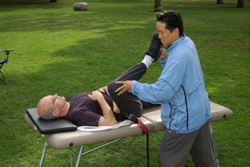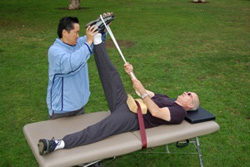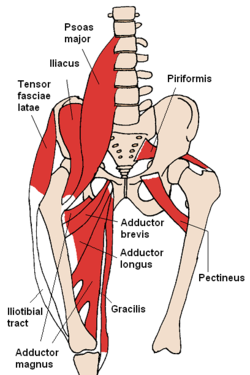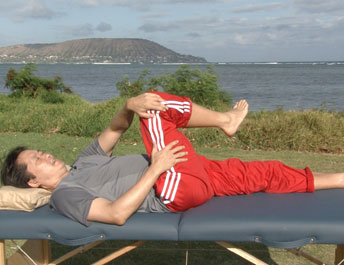Low back pain is caused by excessive tension in the muscular body. Stiff muscles contribute to low back pain. But its not just one or two stiff muscles; its a series of muscles, a collection of symptoms that are causing the problem. The solution for back pain is related to finding the best muscular therapy available. Questions that the back pain client should be asking are: What is the best way to repair my muscles? What is the best way to lengthen muscles?
Low Back Pain Causes
Various muscles support the stability of the pelvis just as spokes support the proper functioning of the wheel. When certain muscles are abnormally tight or weak, the stability of the back is compromised resulting in pain and dysfunction. When the muscles affecting the back are at the proper amount of tension and strength, the pelvis is able to float within its muscle structure. This state is known as tensegrity. The goal in successful treatment is to feel as if you are floating.
Tight muscles cause low back pain
Muscle inflexibility is part of the aging process. That is one reason why back pain is commonly experienced among the older population. As muscles become less flexible, more stress is placed on the low back joint. The anchor of the low back is the pelvis. Numerous muscles attach to the pelvis. Low back pain occurs because a series of muscles that attach to the pelvis have become inflexible. When the pelvis is being pulled on excessively by a number of different muscles, the pelvis is pulled out of its normal position. Displacement of the pelvis causes low back pain.
Activities that cause low back pain
One cause of back pain is excessive sitting. Sitting places six times more pressure on the low back discs (L4, L5, and S1) than standing. Sitting activities, such as desk work, driving, and airline travel; shortens critical muscles that affect the low back. This is one reason why low back pain is a global epidemic. As countries modernize, work evolves around sitting. Sitting all day causes muscles that attach to the pelvis to become tight and cranky. Some of these muscles worth addressing are the: buttocks (gluteals), hamstrings, and psoas.
Tight glutes cause a tight low back.
When looking at a specific pain problem, it is vital to look at the muscles that surround the area that hurts. This is the unique approach of Active Isolated Stretching. The glute muscles are in close vicinity to the site of low back pain. It is logical to conclude that loosening the buttocks muscles is part of the solution in loosening a tight back. Hours upon hours of sitting – sitting at work, driving, and traveling by air, will cause the buttocks muscles to become tight.

Tight hamstrings will pull the pelvis out of position
The hamstring muscles attach from the knee to the pelvis. When the hamstrings are tight, they will pull the pelvis out of normal position. In the seated position, the hamstring muscles are in a shortened position. So prolonged sitting causes the hamstring muscles to stay in a shortened state. Lengthening the hamstring muscles is always part of the protocol to unwinding the low back. Using the wheel analogy, the hamstrings are spokes on the pelvic wheel. The top left photo titled “Active Isolated Stretching: Hamstring” shows one of the six stretches for releasing the hamstring muscle.

A tight psoas compresses the L4, L5, and S1 discs of the low back
In the illustration to the left, the psoas muscle is the long muscle (with the white vertical line) running alongside the spinal column. The psoas attaches to the low back discs and to near the top of the thigh. Have you ever been told that your back problem is at the L4, L5, S1 region? The psoas muscle grabs the low back discs. As the psoas muscle tightens, it pulls the discs around L3, L4, L5, and S1 downwards. The right photo titled “AIS Stretch for Releasing the Psoas Muscle” shows the psoas muscle being stretched.
How to cure low back pain


A tight psoas muscle is not going to be apparent in an MRI or X-ray. In fact, the medical profession has not yet recognized that a tight psoas muscle is a primary cause of low back pain. What could appear on the MRI or X-ray is a herniation, a bulge, or a degeneration in a low back disc. By looking at the psoas illustration, do you see how excessive tightness in the psoas could cause herniation, bulge, or degeneration to the lumbar discs? Most physicians, chiropractors, acupuncturists, physical therapists, and massage therapists do not yet understand the relation between a tight psoas and compression in the L4, L5, and S1 discs. The Mattes Method of Active Isolated Stretching is the breakthrough system that identifies why psoas tightness causes low back pain and how to lengthen the psoas to correct low back pain. When the psoas muscle is re-lengthened using the Mattes Method, pressure is taken off the discs, allowing the healing process to begin.
Be careful when considering surgery for low back pain. The best approach, the safe approach to curing low back pain is Active Isolated Stretching because AIS has the best system for lengthening the muscles that cause low back pain. Massage therapy is also trying to lengthen muscles, but kneading muscles is not as effective as stretching muscles. AIS therapy is a revised form of stretching. It corrects the mistakes of conventional stretching that have made it ineffective at lengthening muscles.
These three muscles: buttocks, hamstrings, and psoas are spokes in the pelvic wheel. Excessive tension in these muscles will take the pelvis out of its neutral position. Buttocks, hamstrings, and psoas muscles are agitated from prolonged sitting, which our lifestyle requires us to do. And these muscles will tighten as a natural process of aging. Fortunately, the remedy is available in the form of Mattes Flexibility Training. A trained therapist can help you restore lost muscle length and thereby allow your pelvis to float within its support structure.






Hi Anthony ,
My mother is suffering from excessive lower back pain. She is suffering from Anterolisthesis grade 1 L5 S1. We are giving her physiotherapy ,but there is not much improvemnt in her condition . She does some stretching and IFT as advised by phsiotherapist she feels better for sometime then the pain again come back lately her pain has worsened she is doing stretching 3 times a day . Im giving her massages but the pain keeps on coming. I dont want to go for surgery.Kindly advise .
Hi Atish, I understand that your mother is suffering from chronic low back pain. This is a worldwide epidemic. As much as 30% of the world population suffers from this condition.
I have created two self-stretching videos that can be purchased. By watching the videos, you can practice the AIS self-stretching method. If your mother is elderly, I recommend that you practice the exercises with her, to improve the chance that she is doing the exercises properly. Remember that the ideal number of repetitions to do is eight; not six as currently stated on my videos. Also, remember not to try to exert too much force on any one repetition. We make gradual gains in range of movement through the repetitions. So in each repetition, you go slightly more than the previous time. But don’t try to do too much in any one stretch. If you feel sore afterwards, this usually means that you exerted too much force during the exercise routine.
Sent by,
Anthony Ohm
i have had back problems for years, L4-L5, C-5-C6-C7 and now C4-C5 fusion/replacement. No one has ever told me why/cause etc.. From reading and looking at Anthony Ohm’s web site I have finally realized my dilemma. Kyphosis! And the only sensible explanation as to why, muscle placement and strength. I have a “hump back” since 12 years old. Not until my career in the automotive industry did I find this to be a problem. But 25 years took its toll and here I am “disabled.” I hope to be in recovery soon and begin my steps with the help of Mr. Ohm’s videos. I will keep you all informed of my progress. Thank you. Steve M.
hi I have sciatica pain going down the hip and leg all the way down to the left foot which is numb, I have been suffering on and off for 20 years. I would like to try the ais system,is there anybody that I can go to?
Thank you
To Tony I.
The proper way to do AIS treatment is to do longer sessions. I commonly work with a client for three and four hour sessions. I recommend that you do the longer session to get maximum benefit.
This website is so informative . I wish I had read it prior to my surgery last year. I probably would have elected not to have the surgery. My doctor told me yesterday that I have flat back syndrome, thus causing my lower back pain and being stooped over is really annoying to say the least. If when standing I pull back my shoulders and push forward my pelvis then I can stand straight..but how long can a person maintain that position. I am in pain constantly, I am so tired of taking pain pills. Can you suggest any other way of alleviating the pain.
Thank You
Anthony Ohm wrote:
Afleccese,
From your self decription, it sounds like your restricted chest and shoulder muscles are causing the upper body to be hunched over. Additionally, it sounds like a tightened psoas muscle is also causing this bent over posture. A doctor can tell you that you need to stand straight, but you won’t be able to maintain correct posture until those key muscles are reshaped and lengthened through the AIS process.
People that have experienced “failed back surgery” can still benefit from Active Isolated Stretching treatment.
Its not too late for you to start feeling better. And you’ll find that AIS treatment will reduce your need for pain pills.
You’ve tried the back surgery, and you’re frustrated with taking the pain pills. Its now time to think of a completely different course of treatment.